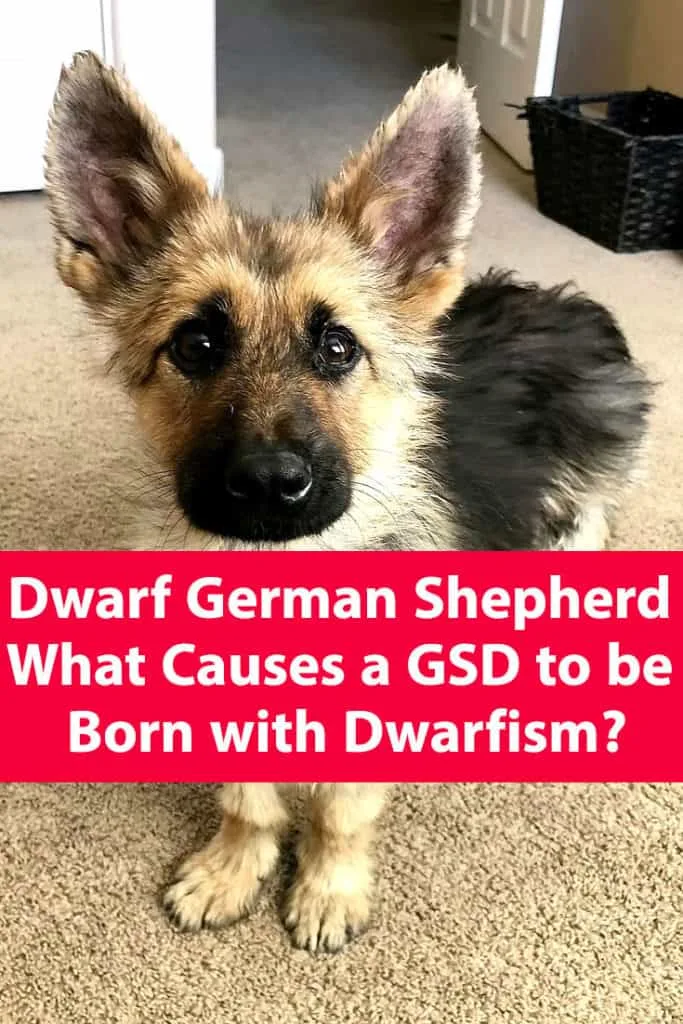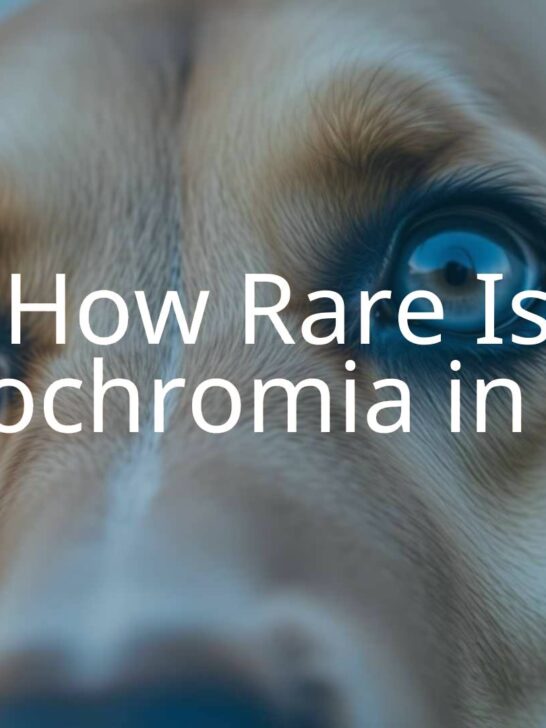Dwarf German Shepherd: What Causes a GSD To Be Born With Dwarfism?
A dwarf German Shepherd is not a special designer or hybrid dog breed. Rather, the term “dwarf German Shepherd” refers to a German Shepherd dog that has genetic dwarfism.
While dwarfism is a condition that is well known in people, fewer dog owners realize that dwarfism can also affect canines.
As well, because certain dog breeds such as Dachshunds and Corgis have been bred to have shortened legs, this is a different type of dwarfism called chondrodysplasia.
German Shepherds are far more likely to inherit pituitary dwarfism, a condition that can be life-limiting in many different ways.
Read on to learn more about the dwarf German Shepherd, what the warning signs and symptoms are and how it affects GSDs.

Dwarf German Shepherd
A dwarf German Shepherd is a dog that has inherited two copies of a recessive gene that is known to cause dwarfism in canines.
The condition is most frequently associated with “backyard” breeders or puppy mill breeders who are not aware of or inclined to do pre-breeding health screening tests to rule out passing on the condition.
Dwarf German Shepherds can have a range of health issues. The most common early warning sign is a GSD puppy’s failure to grow past a certain size.
What Is Pituitary Dwarfism in German Shepherd Dogs?
As Antagene explains, pituitary dwarfism is not a benign condition that simply results in a smaller than normal German Shepherd dog.
It is a condition that is linked to a problem with the pituitary gland where the gland itself fails to grow and develop properly.
Meet the pituitary gland in dogs
A dog’s pituitary gland is every bit as important to their growth as a human’s pituitary gland is vital to our growth.
As Merck Veterinary Manual outlines, the canine pituitary gland is located at the base center of the dog’s brain.
In many ways, the pituitary gland is like the “master gland” of the endocrine system. It controls the activities of other glands in the endocrine system and that in turn controls growth throughout the body.
The pituitary gland and its subordinate glands secrete important hormones that tell the other parts of the body what to do and how much to grow and when to stop growing.
So when the pituitary gland itself doesn’t form properly, those other areas of the body do not form properly either. And many important functions such as metabolism and reproduction also do not happen as they should.
This is basically what is happening when a German Shepherd dog inherits pituitary dwarfism.
Why Does Pituitary Dwarfism Especially Effect the German Shepherd Dog Breed?
As Merck Veterinary Manual explains, pituitary dwarfism is considered to be a juvenile-onset canine disease. In other words, it starts in puppyhood.
There are two main reasons why the pituitary gland may stop forming properly in puppyhood.
The first reason is that the growth is paused because of a tumor forms on the gland itself. The second reason is that the gland itself simply does not form properly.
Pituitary dwarfism affects more German Shepherd dogs than any other dog breed, although certain other breeds may occasionally develop the condition as well.
“Pastoral” working dog breeds are more commonly affected.
Pituitary dwarfism can affect male and female German Shepherd puppies equally.
What Happens to a Dwarf German Shepherd?
There are a number of concerning health impacts to watch for when a German Shepherd puppy is born with pituitary dwarfism.
The condition is visible very early in life – usually by the age of two months old. In most cases, the puppy is not expected to live any longer than five years old and may pass at a younger age.
So let’s take a look at a general timeline of how pituitary dwarfism affects a German Shepherd puppy.
Two to three months old
The German Shepherd puppy starts to slow down in their growth.
This becomes visible around the age of two months as littermates keep getting bigger and the dwarf German Shepherd puppy stops growing at an equal pace.
Three months to one year old
The dwarf German Shepherd puppy does not shed out the puppy coat like their littermates but retains the soft puppy coat.
The coat may become increasingly sparse and, in time, shed out somewhat, but the adult coat does not grow in. Rather, the skin becomes scaly and blackened.
The coat that remains (if any) is still soft like the puppy coat. In most cases, the puppy will retain a larger amount of fur only on the head and hocks.
The puppy teeth may or may not fall out but the adult teeth often fail to grow in. If they do come in, they will be late.
For male puppies, the reproductive organs will be smaller than normal and the testes may not form properly or descend. For female puppies, the first heat cycle may be delayed or prevented.
One year to four years old
Even with a life expectancy that is typically five years or less, a dwarf German Shepherd puppy can easily take up to four years to finish what growing they can do.
The soft cartilage at the top of the leg bones (the “growth plates”) can take up to four years to close fully and harden.
Significant neurological and spinal issues can be present due to the failure of the spinal column to form normally, especially in the first two vertebras in the upper (cervical) spine.
The instability in this part of a dwarf German Shepherd dog’s spine can cause paralysis, pain, movement difficulty, and death.
Another unfortunate side effect of pituitary dwarfism in German Shepherd dogs is anxiety or aggression.
Vice tells the true story of a litter of six GSD puppies, of which three were born with the condition.
Dwarf German Shepherd puppies are much more likely to have behavioral and temperament issues that can cause uncontrolled aggression and/or severe separation anxiety.
Dwarf GSDs that develop either of these conditions can behave in very aggressive ways towards people and other animals.
How Is Pituitary Dwarfism in German Shepherds Prevented?
Pituitary dwarfism is what is called an inherited (genetic) autosomal recessive disorder.
What this means in simple language is that both German Shepherd parent dogs must contribute a copy of the gene in order for a puppy to have a chance of inheriting pituitary dwarfism.
The fact that the incidence of pituitary dwarfism in the German Shepherd dog breed today is estimated to be as high as 20 percent is telling. Many German Shepherd dogs are carriers of the disease.
However, as the Veterinary Information Network (VIN) explains, there is a pre-breeding genetic screening test that can take a blood draw and detect whether a potential parent dog is a carrier of the gene. If the dog is verified as a carrier, that dog should not be bred.
This is the only reliable way to prevent a puppy from inheriting pituitary dwarfism.
This is why dwarf German Shepherds are associated with so-called “backyard” breeders – less knowledgeable or occasional GSD breeders – and puppy mills.
These types of breeders are much less likely to take the time and go to the expense of having pre-breeding genetic screening tests performed before permitting their dogs to mate.
Even if a breeder is absolutely sure their dog comes from a purebred lineage that does not carry the gene, as this Vice story illustrates, it is still vital to have the pre-screening health test performed.
How Is Pituitary Dwarfism in German Shepherds Transmitted?
German Shepherd puppies that have pituitary dwarfism are likely to suffer from a wide variety of health issues throughout their short lifespans.
However, not every puppy that is a dwarf German Shepherd will necessarily have the exact same set of health symptoms.
To that point, a puppy that receives expert veterinary care and appropriate treatment is likely to experience less severe health symptoms along the way.
There is no cure for pituitary dwarfism in any dog breed. But there are treatments that can ease symptoms and in some measure supplement the vital hormones that the malformed pituitary gland is not producing naturally.
According to GSD Pituitary Dwarfism, there are two ways that pituitary dwarfism can show up in a dog.
The dog is a genetic carrier only
When a dog is a genetic carrier of pituitary dwarfism only, this means that dog received only one copy of the recessive gene for the condition.
When a condition is called a “recessive” disease, this means that it takes two copies of that gene to create an active disease.
But carriers, even though they do not show any signs or symptoms of the disease itself, they can pass it on to their puppies if the other parent dog also is a carrier and also passes the gene on to a puppy.
The dog has active pituitary dwarfism
When a dog gets two copies of the pituitary dwarfism gene, that is when you will see the health symptoms that we addressed earlier in this article.
Not only is it likely that a dwarf German Shepherd puppy will grow up to be sterile (not able to breed) but these dogs should never be permitted to breed.
There are some mixes like Poodle German Shepherd mix that maybe look like a dwarf, but that’s not a case.
How Is Pituitary Dwarfism in German Shepherds Treated?
Because dogs that inherit pituitary dwarfism have malformed and malfunctioning pituitary glands, the primary treatment involves supplementing the missing hormones with artificial sources.
By supplementing with artificial (synthetic) versions of some of the missing hormones, a dog with pituitary dwarfism may have less severe symptoms of the condition.
As ResearchGate explains, treating dwarf GSD puppies with synthetic thyroid hormones can help ease symptoms and promote the growth of the coat and adult teeth.
The use of synthetic or porcine (pig) growth hormone and/or progestins can also be supportive of promoting continued growth and development and a more normal coat.
However, it is important to note that supplementing with synthetic hormones can also introduce side effects that may cause further discomfort to the dog. Skin conditions, hot spots, and cysts are some of the many side effects associated with these therapies.
Another treatment that can somewhat promote more normal growth is to delay the spay or neuter procedure.
This allows the dwarf German Shepherd puppy to receive the benefits of continued reproductive hormones at whatever level the dog’s body may be producing these naturally.
However, to avoid any risk that the dwarf GSD might inadvertently mate with another dog and pass along the condition, the owner must be willing to be extra-vigilant about keeping the dog away from other intact dogs.
As well, by choosing to delay the spay or neuter procedure, an intact dwarf German Shepherd dog that develops severe anxiety or aggression may have even worse bouts of these symptoms, which could present a danger to the owner as well as the community.
Daily Life With a Dwarf German Shepherd Dog
More than a few dwarf German Shepherd dogs have garnered significant followings on social media for their cute perpetually puppy-like appearance.
This has helped to raise awareness of pituitary dwarfism in dogs as well.
However, what most people don’t see is the difficulty an owner must go through watching their puppy suffer through bouts of repeated treatment and cope with the health symptoms and shortened life expectancy of this disease.
With careful breeding, pituitary dwarfism in GSD dogs can be prevented.
See a Dwarf German Shepherd Dog
Dwarfism is a condition that can affect dogs as well as people. In this short owner-made YouTube video, you can meet a dwarf German Shepherd who doesn’t seem to know he has dwarfism.
You can watch him running and playing and snuggling and doing all the things German Shepherd dogs do.
While his condition, pituitary dwarfism, is rare in most species, it affects up to 20 percent of all German Shepherd dogs according to the Saartje Foundation.





















